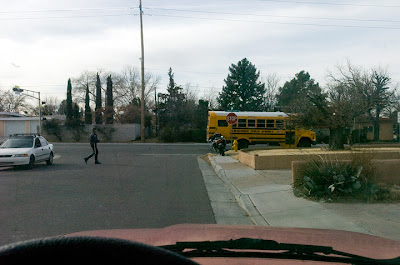 This is Albuquerque Police Traffic Section Officer Floyd Comos completing a traffic stop in the Montezuma Elementary School zone at Indian School Road and Richmond Drive, N.E., on Tuesday morning Feb, 19. He wrote 10 citations in about 30 minutes while the safety zone was in effect.
This is Albuquerque Police Traffic Section Officer Floyd Comos completing a traffic stop in the Montezuma Elementary School zone at Indian School Road and Richmond Drive, N.E., on Tuesday morning Feb, 19. He wrote 10 citations in about 30 minutes while the safety zone was in effect.Albuquerque Mayor Martin Chávez announced, Thursday, Feb. 21, that the automated enforcement program is back citing a spike in violations of red light runners.
Chávez suspended the use of cameras at 20 intersections that record vehicles that enter the intersection after the signal turns red and captures speeding, and the three “speed vans” used to monitor school zones and roadways throughout the city Thursday Feb. 14.
The City’s Safe Traffic Operations Program, also known as the STOP ordinance, has always been controversial since its inception several years back.
The City formed the authorizing legislation to find a way around fundamental legal problems posed by the use of automated enforcement.
Those problems have been explained at length on this site in the past, in the following postings, even those that were just touched upon are listed here:
“Kangaroo Court,” posted May 21, 2006.
“Camel In The Tent,” posted May 22, 2006.
“Stop This Nonsense,” posted June 25, 2006.
“Traffic Cops Versus Technologies,” posted Aug. 03, 2006.
“Lee Logan,” posted Aug. 13, 2006.
“Photo Red Light and Photo Radar Violation Hearings,” posted Oct. 10, 2006.
“Obscured Transparency,” posted Oct. 12, 2006.
“Got a Couple of Seconds?” posted Dec. 20, 2006.
“You Talking To Me? ...Can You Hear Me Now?” posted Dec. 22, 2006.
“Red Light Cameras Want to Make You Blush,” posted Jan. 27, 2007.
"Hello – Hello, I’ve Got To Say Goodbye!" posted Feb. 13, 2007.
“Loyalty Above All Else; Except Honor,” posted March 9, 2007.
“So Right, Yet So Wrong!” posted March 22, 2007.
“100th Blog,” posted March 28, 2007.
“Cleaning Up Little Nit-noyeds!” posted April 21, 2007.
“Blowing in the Wind!” posted April 30, 2007.
“Bamboozled?” posted May 27, 2007.
“A Little Buzz and Instant Gratification,” posted July 1, 2007.
“Whose Who?” posted July 24, 2007.
“It’s Constitution Day!” posted Sept. 18, 2007.
“Another Week in the Political Tumbler,” posted Dec. 10, 2007.
“2007’s Top Stories,” posted Dec. 31, 2007.

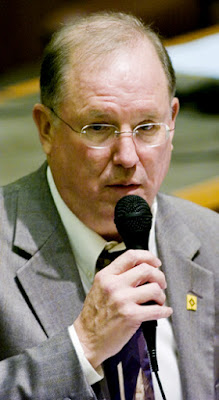 The State Legislature passed a provision, as Senate Bill 442, sponsored by Sen. Michael S. Sanchez, above, D- Valencia County, that would require fines generated through the STOP ordinance, will be processed through the state’s collection process. The money would go to offsetting the Bernalillo County Metropolitan Courthouse operating through a newly established bond guarantee fund.
The State Legislature passed a provision, as Senate Bill 442, sponsored by Sen. Michael S. Sanchez, above, D- Valencia County, that would require fines generated through the STOP ordinance, will be processed through the state’s collection process. The money would go to offsetting the Bernalillo County Metropolitan Courthouse operating through a newly established bond guarantee fund.Mayor Chávez announced Thursday that he was suspending the use of the red light and speed van citation program because the State Legislature had passed a provision that would require fines generated through the City’s Safe Traffic Operations Program, also known as the STOP ordinance, will be processed through the state’s collection process. The money would go to offsetting the Bernalillo County Metropolitan Courthouse operating fund.
Gov. Bill Richardson is leaning towards signing the legislation. There is a fair amount of politics and editorial pontificating about the merits or lack of merits surrounding this bill.
So what’s wrong with this picture?
"The price of freedom is eternal vigilance.," according to Thomas Jefferson.
 The existence of automated enforcement has been around for more than a decade. I recall at least four efforts to get the City Council to support what is now STOP. I spoke against this theory and prevailed until the make up of the council changed and the group, about four years ago led by form Police Captain Craig Loy succumbed to the incessant pressure of Chávez and Police Chief Ray Schultz, who had led the decade long effort to use technology instead of human police officers.
The existence of automated enforcement has been around for more than a decade. I recall at least four efforts to get the City Council to support what is now STOP. I spoke against this theory and prevailed until the make up of the council changed and the group, about four years ago led by form Police Captain Craig Loy succumbed to the incessant pressure of Chávez and Police Chief Ray Schultz, who had led the decade long effort to use technology instead of human police officers.During one such effort, while I boarded a plane I picked up an Albuquerque Journal that reported a bill would be presented at the council meeting while I would still be out of town. I wrote the following letter to the editor and used the name of this site as its title.
Mark G. Bralley February 17,1997
Albuquerque, N. M.
Bill Hume
Albuquerque Journal
Editorial Page Editor
Dear Bill,
I will be out of town for a few days, but could not let the issue of photo radar pass without comment. It seems strange that nobody struck on the basic, "How Government Works" question. Photo radar may work well in Europe, but we revolted against their forms of criminal justice. Our procedures require that minor crimes and traffic offenses occur in the presence of a police officer, not a mechanical box. So, I offer you this letter to the editor with the hopes it might be run this Wednesday prior to the City Council meeting to approve the expenditure of some $50, 000 for two units. I, of course, trust you to edit or use this as it best suits your editorial needs.
What's wrong with this picture?
Mayor Chávez and Chief of Police Polisar have excited our City Council with an impressive display and grandiose promises of capturing speeders without human intervention. This wonderful photo radar is supposed to capture, on one piece of film, the heinous speed, positively identifying the vehicle, and it's driver beyond a reasonable doubt. There is one major problem, because New Mexico does not issue a front license plate, a photo radar picture does not allow for identification of the vehicle's owner (and presumed driver) who can not be sent a ticket. The speeding case can not even make it into court.
Any middle school graduate who stayed awake during civics class will remember the 6th Amendment to the Constitution requires, among other things, that an accused must "be confronted with the witnesses against him." Photo radar is a direct contradiction to community based policing which calls for cooperation of the police through personal public contact. This Robo-Cop simply says, "your guilty, here's the proof, pay a $100 fine, have a nice day, next case!" Photo radar should be called a "Chávez Cop." A mechanical "Chávez Cop" will not listen or discuss an infraction. A "Chavez Cop" can not be cross examined. It won't take more than a couple of trials in Metropolitan Court before photo radar in Albuquerque will be seen as nothing more than another example of fraud, waste and abuse for which this administration has become infamous.
M.G. Bralley
Albuquerque

“There was no significant change in the red light running… something like five percent,” Albuquerque Police Department’s Public Information Officer John Walsh said in an interview about the shut down period. However, the spike, in the first 24-hours, was in speeders at the intersections where there was a recorded 127 percent increase.
Walsh explained that when the mayor ordered the cameras turned off, the triggering devices remained active. Information on the number of vehicles that entered the intersections after the signal had turned red and the number of vehicles speeding continued to be recorded.
Walsh was hesitant to use the initial 24-hour spike, because he said it occurred between a Thursday and a Friday and thought there may have been a natural increase in traffic flow between those days that might account for the five percent increase in those numbers.
Walsh said that, we made a comparison of the 14th at 5 p.m. through the 19th at 5 p.m. and compared it with the previous week; the 7th at 5 p.m. through the 12th at 5 p.m. and noticed an overall 20 percent increase.
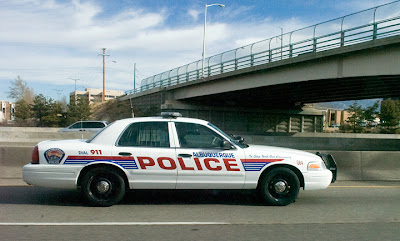 Chief Schultz ordered traffic units and field officers not on calls for service, to step up enforcement in active school zones while the vans were grounded.
Chief Schultz ordered traffic units and field officers not on calls for service, to step up enforcement in active school zones while the vans were grounded.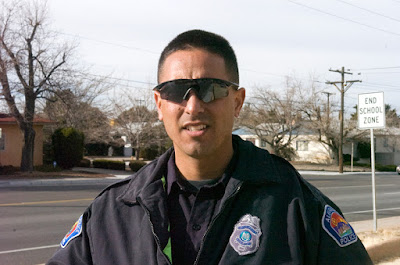 “I get paid to write tickets,” Comos, above, said. So there was little difference for him to go to a school zone while the three speed vans were not working.
“I get paid to write tickets,” Comos, above, said. So there was little difference for him to go to a school zone while the three speed vans were not working. Analysis
AnalysisSenate Bill 442 is simply confusing further an already confused situation.
The additional defining language in Senate Bill 442 reads after the existing public nuisances phraseology,
"…provided that penalties or fines and costs or fees imposed by an ordinance for failure to obey a traffic sign or signal, including a red light violation, or for a speeding offense or violation, shall be subject to the following criteria.”
Nowhere in the Senate Bill 442 is there recognition of how the STOP ordinance is being administered. STOP requires, that in order for there to be a finding, the registered owner of a vehicle videotaped and or photographed running a red light or speeding, must have violated either the State’s traffic statute or the City’s traffic code.
Here is where one of the fundamental legal problems comes to bear. The elements defined in the State’s traffic statute and the City’s traffic code, are very specific, they apply only to the driver, not the registered owner. The STOP ordinance cannot presume guilt without a conviction in Metropolitan Court.
New Mexico State Statutes 34-8A-3. Metropolitan court; jurisdiction.Instead of using the Metropolitan Court for the adjudication of all city ordinances, including traffic offenses as required by State Statute, the City of Albuquerque created its own judicial process, the Administrative Hearing Office.
A. In addition to the jurisdiction provided by law for magistrate courts, a metropolitan court shall have jurisdiction within the county boundaries over all:
(1) offenses and complaints pursuant to ordinances of the county and of a municipality located within the county in which the court is located except municipalities with a population of more than two thousand five hundred but less than five thousand persons in the 1980 federal decennial census; provided that the metropolitan court shall not have jurisdiction over uncontested municipal parking violations;
(2) civil actions in which the debt or sum claimed does not exceed ten thousand dollars ($10,000), exclusive of interest and costs; and
New Mexico State Statutes 32A-2-29. Motor Vehicle Code violationsThere are two legal points in the State Statute that seem to conflict with the fact that the State runs all hearings regarding the adjudication of City Ordinances:
A. The municipal, magistrate or metropolitan court shall have original exclusive jurisdiction over all Motor Vehicle Code or municipal traffic code violations when the person alleged to have committed the violation is a child,
Metropolitan Court adjudicates all city ordinances, including traffic offenses.
District Court adjudicates all public nuisances cases.
New Mexico State Statutes 30-8-8 Abatement of a Public NuisanceThe adjudication of public nuisances cases in District Court seems to be the only exception to the statute requiring all city ordinances to be handled in Metropolitan Court. The reason may partly be that private citizens may bring public nuisances complaints to court even if a county, city or town does not act.
B. A civil action to abate a public nuisance may be brought, by verified complaint in the name of the state without cost, by any public officer or private citizen, in the district court of the county where the public nuisance exists, against any person, corporation or association of persons who shall create, perform or maintain a public nuisance.
The City Attorneys have argued before the City Council and in District Court, that the language in the home rule section, stating a municipality which has adopted a charter pursuant to Article 10, Section 6 of the constitution of New Mexico, may by ordinance, define a nuisance, abate a nuisance and impose penalties upon a person who creates or allows a nuisance to exist, allows them to create their own adjudication process, separate from the state, using the words, “abate a nuisance and impose penalties. “
However, all city ordinances provide for a penalty. There is a provision entitled the General Penalty section, which states that where a city ordinance does not specifically provide for a penalty, the penalty is a petty misdemeanor. In the case of traffic offenses the code is specific:
City of Albuquerque’s Code of Ordinances § 8-1-1-1 OBEDIENCE TO CODE REQUIRED.Because the City uses its own Administrative Hearing Officer, instead of Metropolitan Court, how can the State mandate that all penalties or fines and costs or fees imposed by an ordinance be funneled through the Metropolitan Court funding system?
It is a petty misdemeanor for any person to do any act forbidden or fail to perform any act required in this Traffic Code.
The second part of Senate Bill 442 mandates and limits “the total amount of assessed fines, fees and costs shall not exceed seventy-five dollars,” for a STOP ordinance violation.
The bill’s provision then goes on, “the total amount assessed in fines, fees and costs by the municipality shall be distributed to the administrative office of the courts, of which ten percent of the total amount assessed shall be credited to DWI drug court programs and ninety percent of the total amount assessed shall be transferred to the New Mexico finance authority for deposit into the metropolitan court bond guarantee fund.”
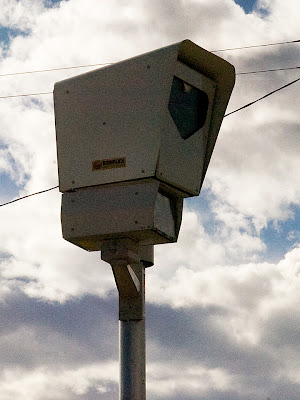 This is the section that Chávez found intolerable because he asserts that after paying the contractor, RedFlex, there would not be enough money left to fund the Administrative Hearing Office.
This is the section that Chávez found intolerable because he asserts that after paying the contractor, RedFlex, there would not be enough money left to fund the Administrative Hearing Office.If the City were using the Metropolitan Court as the adjudication method, the costs associated with the Administrative Hearing Office, would instead be borne by the State.
The bill also establishes an annual audit to review the City’s program creates a metropolitan court bond guarantee fund to pay the operating cost of the court.
The Statute does not mandate that public nuisances should be heard in Metropolitan Court or in District Court as current law dictates. The absence of specifics in the bill does not help clarify the problem.
Today, Mayor Chávez is scheduled to meet Gov. Richardson to talk about the legislation. Chávez will attempt to convince Richardson to veto the bill.
 My Take
My TakeWhether Gov. Richardson signs or vetoes Senate Bill 442 is irrelevant. If challenged, the courts are going to run into a number of issues that a very few critics have been trying to hone in on. While most opposed to STOP have capitalized on the general due process issues of having a City Administrative Hearing Officer who is defined in the ordinance as,
”An administrative hearing officer with authority from the Mayor to enforce and adjudicate matters under this article,”the hearing officer’s roles conflict with the general legal concept, that judges are impartial. The mere idea that the hearing officer is “enforcing” an ordinance, the role belonging not to the judicial branch, but to law enforcement, is an anathema.
Most critics also complain about the true purpose of the automated enforcement program. The mayor and chief of police argue that it is a matter of public safety. While the critics point out that it is a multi million dollar cash cow.
 If the legislators had written a bill requiring the STOP ordinance to be adjudicated in Metropolitan Court, so the assessed fines, fees and costs could go through the state revenue system, another ugly reality would have surfaced. The Stop ordinance is unenforceable in traffic court using the criminal burden of proof.
If the legislators had written a bill requiring the STOP ordinance to be adjudicated in Metropolitan Court, so the assessed fines, fees and costs could go through the state revenue system, another ugly reality would have surfaced. The Stop ordinance is unenforceable in traffic court using the criminal burden of proof.The original proponents of STOP had attempted to use technology in automated enforcement for more than a decade before the City Council was sold the current bill of goods.
The authors of STOP have tried to wiggle their way through the legal limitations avoiding the existing legal process, in which they would likely not prevail, by creating an entirely new hybrid form of legal review that eviscerates the rule of law under the guise and call for “public safety.” In the findings and intent there is scatological hyperbole.
Instead of STOP being a regular traffic offense, the Council has approved the unique concept that the registered owner is the violator and a public nuisance.
City of Albuquerque’s Code of Ordinances § 7-11-1 FINDINGS AND INTENT.Why should that be? Why should offenses that the council finds so serious that the remedies of existing law are insufficient, make those offenses civil and not criminal? Could it be that the City has no authority to change the degree of a crime? They may not make a traffic offense, which is classified a misdemeanor, into a felony. Only the State’s Legislature may determine what offenses are felonies. Legislators seem to believe that the traffic code, as written, is just fine. The use of civil action is always available to victims of negligent or reckless driver who may have also run a red light or sped before causing an accident. It seems that the State, through its legislature, has decided not to agree with the City of Albuquerque’s mayor and council on the approach to dealing with the perceived problems of minor traffic offenses, that on occasion cause major accidents.
(B) City Council finds that many states and municipalities across the country have experienced substantial decreases in red light violations by using red light cameras. City Council finds that red light cameras produce scientifically reliable evidence of red light violations. City Council finds that it is reasonable for any police officer to rely on red light camera evidence even if the officer did not personally observe the violation. City Council finds that red light cameras save lives.
(C) Red light violations are a nuisance that must be abated by assessment of fines to compensate the city and taxpayers who do not commit these violations. Drivers who fail or refuse to pay the fines and repeatedly run red lights create a severe nuisance that will not be abated unless the city temporarily seizes the cars of these drivers and thus removes the instrumentality used to create this nuisance. City Council finds that the current penalty under state law for running a red light is inadequate to meaningfully address the nuisance and that the City of Albuquerque must implement meaningful civil remedial measures that will stop red light violations and save lives. Red light violations are causally connected to death and serious injury to a degree not evident with regard to other traffic infractions.
(F) The City Council declares that this article is a nuisance abatement article enacted pursuant to the city's inherent authority under state law and that the remedies are purely civil and not criminal in nature.
Stop is written to avoid traffic offenses being handled as traffic offenses, by declaring them to be “civil” public nuisance to bypass the requirement that an officer witness and immediately arrest a driver observed to have violated the traffic code.
City of Albuquerque’s Code of Ordinances § 8-1-3-7 CITATIONS ISSUED BY UNIFORMED, ON-DUTY OFFICERS.
All citations issued under this Traffic Code shall be issued by a uniformed, on-duty police officer. No form of complaint other than a citation shall be issued.
 State Statute also has controlling language:
State Statute also has controlling language:66-8-124. Arresting officer to be in uniform.The City seems to believe that it is above the State laws that would restrain them from enforcing STOP as they see fit.
A. No person shall be arrested for violating the Motor Vehicle Code [66-1-1 NMSA 1978] or other law relating to motor vehicles punishable as a misdemeanor except by a commissioned, salaried peace officer who, at the time of arrest, is wearing a uniform clearly indicating his official status.
66-7-8. Provisions uniform throughout state.Using cameras violates the State Constitution:
The provisions of Article 7 of Chapter 66 NMSA 1978 shall be applicable and uniform throughout this state and in all political subdivisions and municipalities therein and no local authority shall enact or enforce any ordinance, rule or regulation in conflict with such provisions unless expressly authorized herein. Local authorities may, however, adopt additional traffic regulations which are not in conflict with such provisions.
Sec. 18. [Due process; equal protection; sex discrimination.]I don’t believe that this matter will resolve itself any time soon. The legislature missed the mark. The District Courts are more than reluctant to address the issue of proper jurisdiction and have sidestepped the question of what would happen to their case volume should hundreds of public nuisance abatement cases be filed in their system.
No person shall be deprived of life, liberty or property without due process of law; nor shall any person be denied equal protection of the laws. Equality of rights under law shall not be denied on account of the sex of any person.
The childish behavior displayed by the leaders of the state’s largest governments is deplorable. It is only superceded by their refusal to comport with the fundamentals of law making.
No comments:
Post a Comment